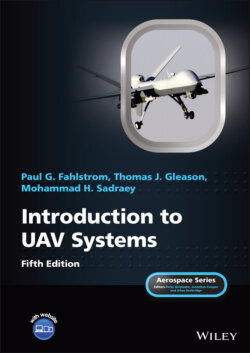Читать книгу Introduction to UAV Systems - Mohammad H. Sadraey - Страница 60
2.3.3 Very Small UAVs
ОглавлениеFor the purposes of this discussion, “very small UAVs” range from “micro” sized, which are about the size of a large insect, up to an AV with dimensions of the order of a 30–50 cm (12–20 in). There are two major types of small UAVs. One type uses flapping wings to fly like an insect or a bird and the other one uses a more or less conventional aircraft configuration, usually rotary wing for the micro size range. The choice of flapping wings or rotary wings often is influenced by the desire to be able to hover and land/perch on small surfaces to allow surveillance to continue without having to expend the energy to hover. Another advantage of flapping wings is covertness, as the UAV may look a lot like a bird or insect and be able to fly around very close to the subjects of its surveillance or perch in plan‐view without giving away the fact that it is actually a sensor platform.
At the small end of this range and for flapping wings, there are many special issues related to the aerodynamics that allow the small UAVs to fly. However, in all cases the basic aerodynamic principles and equations apply, and one needs to understand them before proceeding to the special conditions related to very small size or flapping wings. Part Two of this book introduces the basic aerodynamics and some discussion to the issues for small size and flapping wings.
Examples of very small UAVs include the Chinese DJI mini 2, which is a quadcopter that can hover (i.e., vertically takeoff and land); the Israeli IAI Malat Mosquito, which is an oval flying wing with a single tractor propeller; the US Aurora Flight Sciences Skate, which is a rectangular flying wing with twin tractor engine/propeller combinations that can be tilted to provide “thrust vectoring” for control; and the Australian Cyber Technology CyberQuad Mini, which has four ducted fans in a square arrangement.
The Mosquito wing/fuselage is 35 cm (14.8 in) long and 35 cm (14.8 in) in total span. It uses an electric motor with batteries and has an endurance of 40 minutes, and claims a radius of action of about 1.2 km (0.75 mile). It is hand or bungee launched and can deploy a parachute for recovery.
The DJI Phantom 4 Pro quadcopter has four electric engines, dimensions of 9.9 in × 15.7 in × 6.75 in, and a takeoff weight of about 3 lb. It is equipped with an electro‐optic camera and autopilot that allows fully autonomous waypoint navigation. It can be controlled via a smart phone as a ground control station using a Wi‐Fi connection, by which the live videos are received.
The Skate wing/fuselage has a wingspan of about 60 cm (24 in) and length of 33 cm (13 in). It folds in half along its centerline for transport and storage. It has twin electric motors on the leading edge that can be tilted up or down and allow vertical takeoff and landing (VTOL) and transition to efficient horizontal flight. There are no control surfaces, with all control being accomplished by tilting the motor/propeller assemblies and controlling the speed of the two propellers. It can carry a payload of 227 g (8 oz) with a total takeoff weight of about 1.1 kg (2 lb).
The CyberQuad Mini has four ducted fans, each with a diameter of somewhat less than 20 cm (7.8 in), mounted so that the total outside dimensions that include the fan shrouds are about 42 cm by 42 cm (16.5 in). The total height including the payload and batteries, which are located in a fuselage at the center of the square, is 20 cm (7.8 in).
The CyberQuad Mini includes a low‐light level electro‐optic camera or thermal camera and a control system that allows fully autonomous waypoint navigation. The toy has two onboard cameras, one facing forward and one facing down, and is controlled much like a video game from a portable digital device such as a tablet computer or a smart phone. Drawings of these UAVs are shown in Figure 2.2.
Figure 2.2 Very small UAVs
